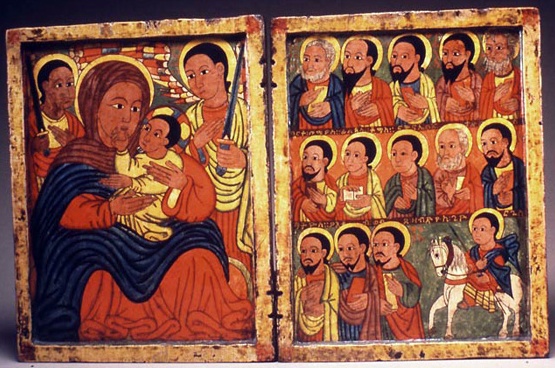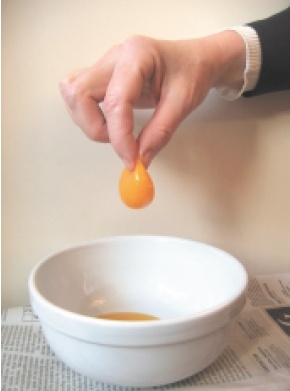Making Egg Tempera Paint
This activity is part of The Walters Art Museum's Integrating the Arts: Mummies, Manuscripts and Madonnas, an interactive Web site for middle school students focused on arts integration.

Before the invention of oil paint in the European Renaissance, artists created paintings with powdered, colored pigments mixed with egg yolk as binding agent. We call this egg tempera paint. This Ethiopian Diptych with Mary and Her Son and Apostles and Saints George and Theodore was painted with this type of tempera paint. Medieval artists ground stones and minerals into powder to create different colors. In this activity you’ll make egg tempera paint in much the same way that medieval artists did, using powdered pigments instead of grinding your own minerals.
You’ll need:
- Eggs, at least one but extra are recommended to allow for breaks!
- Artists’ pigments like those made by Gamblin paints are most closely related to the pigments ground by medieval artists. If artist pigment isn’t available, regular powdered tempera such as Rich Art Fresco Dry Tempera or cakes that can be ground such as Blick or Prang Tempera Cakes will work nicely. All should be available at your local art supply stores.
- Small mixing bowls
- Paper towels
- Toothpicks or other sharp, pointed tools
- Mixing spoons, popsicle sticks or other mixing implements
- Water
- Paintbrushes
- 8” x 10” heavy watercolor paper
Today most artists buy their paint, artists hundreds of years ago made all of their own materials. Tempera Paint consists of, pigment and binder in the form of egg yolk. Honey was sometimes added to keep the paint from drying so quickly, and water was also added to thin the paint.
Pigment is what gives color to paint. The pigment particles are insoluble (meaning they won’t dissolve) and form a suspension in the binder. There are a great many pigments in the world, from a variety of sources. The first pigments came from the earth in such forms as minerals, vegetables or animals. There are also a great number of binders for pigments. It is these binders that give us the many different types of paint such as oil, watercolor and tempera. Each binder gives a unique quality to the pigment and adheres to the surface in a different way.
Paint is a special kind of emulsion because the pigment particles are suspended in a liquid (emulsifier) such as oil, egg yolk, or even glue. When emulsions are spread out the emulsifier is able to harden.
Have you ever cracked open an egg and left it out for too long? Because egg tempera is made with egg yolk it dries very quickly and it cannot be stored. Artists had to work very quickly and in small areas at one time. For medieval artists making their own paint, mixing too little of one color was a disaster – mixing more paint to match the first batch perfectly was very difficult. Mixing too much paint was a waste of expensive materials.
Activity:

Handling an egg yolk
- Crack an egg over a bowl, and separate the yolk from the white by pouring the yolk from one half of the shell to the other, allowing the white to fall into the bowl below.
- After all of the egg white is gone, gently pour the intact egg yolk into the palm of one hand. Carefully roll the egg yolk from one hand to the other, each time wiping your free hand on paper towels to remove excess egg white.
- When you are convinced the egg yolk is dry, pinch the yolk and hold it up as a mother cat picks up her kittens. Hold the yolk over a clean bowl and puncture the yolk with a toothpick or other sharp tool so the contents of the yolk sac runs into the bowl, leaving the yolk sac behind. Discard the yolk sac. Always wash with soap and dry your hands thoroughly after handling raw eggs.
- Add powdered pigment a little at a time to the egg yolk and mix until the powder is incorporated and the paint is the color you desire. Next add water sparingly until the paint is fluid and can be used with a brush. Tempera that is too thin or too thick will crack when it dries, so be careful to add water just a little at a time until the consistency is like thin gravy. Remember, you can always add more powdered pigment or water, but you can’t take it away once you have added too much.
- Paint a swatch of your egg tempera paint onto the watercolor paper. Notice how long it takes the paint to dry. Try experimenting with mixing different colors and consistencies, and note the differences when the paint is both wet and dry. How does egg tempera paint compare to other paint you have used?